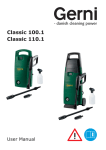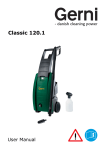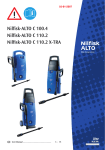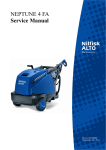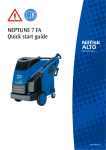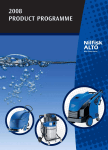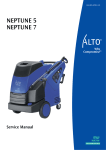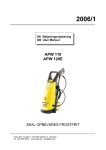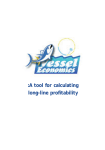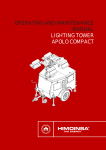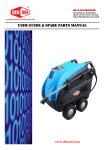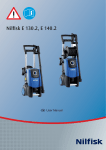Download 3 Before starting the pressure washer
Transcript
POSEIDON 2-31, 3-36, 5-67 PE POSEIDON 5-54 DE User Manual Copyright © 2007 Gerni Contents Symbols .................................................................................................4 1 Important safety notes .................................................................................................6 2 Description 2.1 Intended use.............................................................................6 2.2 Operating elements ..................................................................6 3 Before starting the pressure washer 3.1 Setting up the pressure washer ................................................7 4 Operation and use 4.1 Connections .............................................................................7 4.2 Start the pressure washer ........................................................8 4.3 Using detergents ......................................................................9 5 After using the pressure washer 5.1 Switching off the pressure washer .........................................10 5.2 Disconnecting supply lines .....................................................10 5.3 Storing the cleaner (frost-free) ...............................................10 6 Maintenance 6.1 Maintenance plan ...................................................................11 6.2 Maintenance work ..................................................................11 7 Troubleshooting 8 Further information ...............................................................................................13 8.1 8.2 8.3 8.4 Recycling the pressure washer ..............................................14 Warranty .................................................................................14 Technical specifications ..........................................................15 Declaration of Conformity .......................................................15 3 Symbols Before starting up your highpressure washer for the first time, this instruction manual must be read through carefully. Save the instructions for later use. Safety instructions marked with this symbol must be observed to prevent danger to persons. , This symbol is used to mark safety instructions that must be observed to prevent damage to the machine and its performance. This symbol indicates tips and instructions to simplify work and to ensure a safe operation. 1 Important safety notes Before using the high-pressure washer, be sure to also read the enclosed operating instructions and keep them within reach at all times. Before use The high-pressure washer may only be used by persons instructed in its use and who have been expressly authorised to do so. Operate the pressure washer only in an upright position! General Use of the high-pressure washer is subject to the applicable local regulations. In addition to the operating instructions and the binding accident prevention regulations in the country of use, the generally recognised rules for safe working must also be observed. Any method of use endangering the safety of persons or equipment is forbidden. 4 Before use, check that the highpressure cleaner is in a safe and proper condition. Important notes: Do not connect the pressure washer directly to the public drinking water mains (observe DIN 1988 and EN 1717). A connection is permitted, however: • briefly to a pipe interrupter with moving section • with a free outlet Water may also be drawn from an open container or from a well or surface water not intended for the drinking water supply. Please use suction set for this. Ensure that neither dirty water nor liquids containing solvents are sucked in. Please observe the regulations and provisions applicable in your country. Before putting the high-pressure washer into service, carry out a visual check of all the major components. High-pressure jets can be dangerous if misused. The jet must not be directed at persons, animals, live electrical equipment or the pressure washer itself. During operation of the washer, recoil forces are produced at the spray lance and, when the lance is held at an angle, a torque is also created. The lance must therefore be held firmly in both hands. Risk of injury! Do not direct the jet towards yourself or towards other persons in order to clean clothes or footwear. Do not use the washer when other people without protective clothing are in the working area. Check that cleaning will not result in dangerous substances (e.g. asbestos, oil) being washed off the object to be cleaned and harming the environment. Do not clean delicate parts made of rubber, fabric, etc. with the round jet. Hold the nozzle at a distance of at least 15 cm when cleaning with the highpressure flat jet. Although extremely easy to operate, children should not be allowed to use the pressure washer. Do not use the high-pressure hose for lifting loads. Do not continue to use the washer if the quick coupling or high-pressure hose is damaged. Never use the machine in areas where there is danger of fire or explosion. When using the pressure washer, stand at least 1 m from buildings, etc. Ensure an adequate air circulation. Do not cover the washer or operate it in inadequately ventilated rooms! The exhaust fumes are dangerous! Store the pressure washer where it will not be exposed to frost! Never operate the pressure washer without water. Even brief shortages of water result in severe damage to the pump seals. Please contact the Gerni service department or an authorised specialist work-shop for all other maintenance or repair work! Testing The machine satisfies IEC/EN 60335-2-79 standards. Maintenace and repair CAUTION! Before cleaning and servicing the high pressure washer, always remove the ignition plug cable first. Carry out only the maintenance operations described in the operating instructions. Use only original Gerni spare parts. Do not make any technical modifications to the high pressure washer. CAUTION! High pressure hoses, fittings and couplings are important for the safety of the washer. Use only high pressure parts approved by the manufacturer! The high pressure washer should be examined as needed or at least once a year by a technician to make sure that it is fail-safe. Our service technicians are at your disposal for assistance and advice. Safety device The high pressure pump is equipped with a safety valve that redirects the by-pass pressure back to the suction side of the pump. The safety device is set and sealed at the factory and must not be adjusted. CAUTION! Failure to observe these instructions can endanger your safety. 5 2 Description 2.1 Intended use This high pressure washer has been designed for professional use in - agriculture - transport industry - construction industry etc. 2.2 Operating elements 1 2 3 4 5 6 7 8 9 10 11 12 Start/stop switch Lance Holder for lance Holder for high pressure hose High pressure hose Spray gun Water connection and water inlet filter Connection for high pressure hose Pressure gauge Oil level gauge Regulation of water volume Filling of oil 6 3 Before starting the pressure washer 3.1 Setting up the pressure washer 1. Before using the pressure washer for the first time, check it carefully to detect any faults or damage. 2. In the event of any damage contact your Gerni dealer immediately. 3. Check whether the oil level is in the middle of the oil inspection glass. This also applies to machines with gear. 4 Operation and use 4.1 Connections 4.1.1 Connecting the lance to the spray gun A C B 1. Pull the blue quick coupling of the spray gun forward and lock it by turning it to the left. 2. Insert the nipple of the lance into the quick coupling and turn the blue quick coupling grip to the right. 3. Pull the lance (or other accessory) forward to check that it is securely attached to the spray gun. NOTE! Always remove any dirt from the nipple before connecting the lanse to the spray gun. 4.1.2 Connecting the high pressure hose and the water hose 1. Connect the high pressure hose to the high pressure inlet by means of the quick coupling. Use max. 50 m extension hose. 2. Before connecting the water hose to the washer, rinse the water hose briefly to prevent sand and other dirt from entering into the washer. 3. Open the tap. (continued -->) 7 4.1.3 Fuelling NOTE! See chapter 8.3 for required quantity of water and water pressure. In the case of poor water quality (sand, etc.), we recommend that a fine water filter is fitted in the water inlet. WARNING! Always shut off the engine and let it cool for at least two minutes before fuelling. Avoid spilling fuel. If you do spill fuel when fuelling, do not start the engine before the spilled fuel has evaporated. If the washer is on a trailer, any fuel spills must be wiped up before the machine is started. Never expose the machine to an open flame. Smoking is prohibited during fuelling. Also read the operating manual for the fuel engine. Note: Never operate the machine in a closed room; the exhaust fumes are dangerous. 4.2 Start the washer 4.2.1 Switching on the washer when it is connected to a water supply Follow the safety instructions in chapter 1! 1. Start the engine. (See the operating manual for the fuel engine.) 2. Unlock the spray gun and operate it. 3. Lock the safety catch even during short pauses. NOTE! Operate the spray gun several times at short intervals to vent the system. 4.2.2 Switching on the washer when it is connected to open tanks (suction mode) 1. Before connecting the suction hose to the washer, fill the hose with water. machine run without spray lance mounted until all air has escaped. During work breaks of more than three minutes, switch off the washer. 2. Start the washer. 3. Unlock the spray gun and activate it. 4. When using this machine in suction mode, first ensure that the system has been bled of air by letting the 8 NOTE! For automatic suction from a tank, watercourse or similar supply, the inlet hose must be filled with water before you start. The suction height depends on the water temperature. Max. suction height (see section 8.3 Technical Data) is reached with cold water (up to 8°C). With 70°C/60°C warm water, the machine must be under or at the water level. (continued -->) If the water being suctioned contains particles, a suction filter must be mounted on the end of the hose. In case of risk of running sands, a sand filter must be attached. 4.2.3 Start POSEIDON PE 4.3 Using detergents 1. Switch on the ignition by pushing the ON/OFF button of the machine. The charging + oil light indicators will turn on. 2. Move the throttle lever to SLOW or RUN position. 3. Push the start button until the machine starts. Now the charging + oil light indicators will turn off. If not, stop the machine immediately and contact Gerni service department. 4. The machine can be started by means of the starter rope if the battery has gone flat. See manual from Yanmar. Detergent can be added by means of the detergent injector. 1. Dilute detergent according to the manufacturer's instructions. 2. Set the pressure to the lowest setting on the lance. CAUTION! Never allow detergent to dry on the surface to be cleaned as this may cause damage. 9 5 After using the washer 5.1 Stop the pressure washer 1. Stop the engine. 2. Close the tap. 3. Operate the spray gun until the wasser is depressurized. 4. Lock the safety catch. Switching off POSEIDON DE 1. Stop the washer by moving the throttle lever to STOP position. 2. Switch off the ignition by pushing the ON/OFF button. The light indicators will now turn off. 5.2 Disconnecting supply lines 1. Shut the fuel cock. 2. Remove the water hose from the washer. 5.3 Storing the washer (frost-protected) 1. Store the pressure washer in a dry room without danger of frost. , IMPORTANT! If the high-pressure washer is stored in a room with temperatures around or below 0°C, anti-freeze should be drawn into the pump beforehand: 1. Remove the water inlet hose from the washer. 2. Remove the lance. 3. Start the washer and stop it again after max. one minute. 10 4. Connect the suction hose to the water inlet of the washer and place it in a tank containing anti-freeze. 5. Start the washer. 6. Hold the spray gun over the tank containing anti-freeze and activate it to start suction of anti-freeze. 7. During suction operate the spray gun two or three times. 8. Lift the suction hose from the tank containing anti-freeze and activate the spray gun to pump out the remaining antifreeze. 9. Stop the washer. 6 Maintenance 6.1 Maintenance plan weekly every six months or 500 operating hours as required • 6.2.1 Clean water filter • 6.2.2 Clean high pressure nozzle • 6.2.3 Check oil level 6.2.4 Change oil - Note: First time after 50 hours • Maintenance of motor according to separate operating instructions from the engine supplier 6.2 Maintenance work 6.2.1 Clean water filter A water filter is fitted on the water inlet to prevent large particles of dirt from entering into the pump. 1. Unscrew the union nut. 2. Remove the filter and rinse it. Replace damaged filter. 3. Tighten the union nut gently, so as to avoid damaging the gasket. 6.2.2 Clean high pressure nozzle A blocked nozzle causes excessive pump pressure. It must therefore be cleaned immediately. WARNING! Use the cleaning needle only when the spray lance has been removed. 1. Stop the washer. 2. Remove the lance. 3. Clean the nozzle with a needle. 4. Rinse the lance with water from the nozzle side. NOTE! The fuel engine stops automatically if the oil level is low. You can start the petrol engine again once you have added oil (does not apply to POSEIDON 2-31 PE). 11 6.2.3 Checking the oil level 1. Check whether the oil level is in the middle of the oil inspection glass. Top up with oil if necessary (see section 8.3 for type of oil). 6.2.4 Changing the pump/ gear oil 1. Before changing the oil, allow the pressure washer to become warm. 2. Unscrew the plugs at the top and the bottom of the pump. 3. Allow the oil to drain into a suitable container (min. 1 l capacity) and dispose of oil in compliance with regulations. 4. Mount plug at the bottom of the pump. 5. Fill pump with fresh oil (see 8.3 for oil type and quantity). 6. Check the oil level (see 6.2.3). 12 7 Troubleshooting Fault Pressure drop Cause Remedy > Air in the system • Vent the system by operating the spray gun several times at short intervals. If necessary, dismount the lance (see section 4.2.2). > High-pressure nozzle blocked/worn • Clean/replace the highpressure nozzle. > Pressure control on the lance is not set correctly • Set the required working pressure. > Engine speed too low • Contact Gerni Service Department. > Lack of water • Open the tap. > Pump/accessories partially frozen • Thaw machine and accessories. > Water inlet hose is too long or its cross-section too small • Use prescribed size of water inlet hose. > Lack of water caused by blocked water filter • Clean the water filter in the water connection (never operate the machine without water filter mounted!) > Lack of water because max. permissible suction height has not been heeded • See chapter 4.2.2. > Water too hot • See chapter 4.2.2. > Pump draws in air (only possible in suction mode) • Check that the suction set is air-tight. Repeat aeration. Excess pressure > Engine’s throttle control is defective (accessory) • Give less gas/contact Gerni Service Department. The motor does not start > Low fuel level • Open fuel cock/fill with fuel. > Low oil level in engine • Fill with oil. > The pump is blocked or frozen • Thaw machine/contact Gerni Service Department. Pressure fluctuations In suction mode 13 Cause Fault Remedy The motor stops > Low oil level in engine • Fill with oil. When a detergent injector is used > Injector is dirty or suction hose is blocked • Clean. > Detergent tank is empty • Fill the detergent tank. > The lance is not set to low pressure • Adjust the lance to low pressure. > Low fuel level • Open fuel cock/fill with fuel. 8 Further information 8.1 Recycling the pressure washer If the pressure washer is discarded, make it unusable immediately 1. Dismount the ignition plug. be recycled. Contact your local waste disposal site. If you have any queries, please contact your local authorities or your nearest dealer. The pressure washer contains valuable materials that should 8.2 Warranty Your Gerni product is guaranteed for 12 months from date of purchase (purchase receipt must be presented) on the following conditions: • • • 14 that defects are attributable to flaws or defects in materials or workmanship. (Usual wear and tear as well as misuse are not covered by the guarantee). that repairs have not been carried out or attempted by other than Gerni-trained service staff. that only original accessories have been applied. • • that the product has not been exposed to abuse such as knocks, bumps or frost. that the instructions in the manual have been carefully observed. A warranty repair comprises the replacement of defective parts, but it does not cover freight and packaging charges. Besides we refer to national Sale of Goods Act. Any illegitimate guarantee repair will be invoiced. (I.e. malfunctions due to causes mentioned in section “7 Trouble shooting” of the instruction manual). 8.3 Technical specifications POSEIDON 2-31 PE POSEIDON 3-36 PE POSEIDON 5-67 PE POSEIDON 5-54 DE Working pressure bar 140 140 230 195 Water volume Qmax l/h 700 840 1150 1000 Water volume QIEC l/h 650 750 1100 950 Cleaning impact kg/Force 3.1 3.6 6.7 5.4 Max. water inlet temperature °C Min./max. water inlet pressure bar 60 60 70 70 1/10 1/10 1/10 1 Dimensions l x w x h mm 800x565x1010 Weight kg 35 38 68 110 Sound power level, Lwa Vibration level at spray handle dB(A) 101 105 105 110 Thrust N 24 58 45 1 1.5 1 1 Oil quantity in pump/gear l 0.18 0.18 0.56/0.27 0.56/0.27 Oil quantity in motor l 0.6 0.6 1.1 1.65 m/s2 1000x615x1150 < 2.5 Suction height (at max. 8°C) Oil type (motor/pump/gear) 26 SAE 15 - 40 We reserve the right to make alterations. 8.4 EC Declaration of Conformity EC Declaration of Conformity High Pressure Washer Product: Type: Description: POSEIDON 2-31 PE POSEIDON 3-36 PE POSEIDON 5-67 PE POSEIDON 5-54 DE 250 bar / 20 MPa Petrol driven Diesel driven EEC Machine Directive EEC EMC Directive The design of the unit corresponds to the following pertinent regulations: Applied harmonised standards: 98/37/EEC 2004/108/EEC EN 2100-1, EN 12100-2 EN 60335-2-79 EN 55012 DIN EN 60335-2-79 Applied national standards and technical specifications: Dipl.-Ing. Wolfgang Nieuwkamp Test and Approvals Bellenberg, 01.12.2005 15 Nilfisk-Advance Pty LTd 48 Egerton St Silverwater NSW 2128 106169230 (01.2007) Phone: 1300 556 710
















